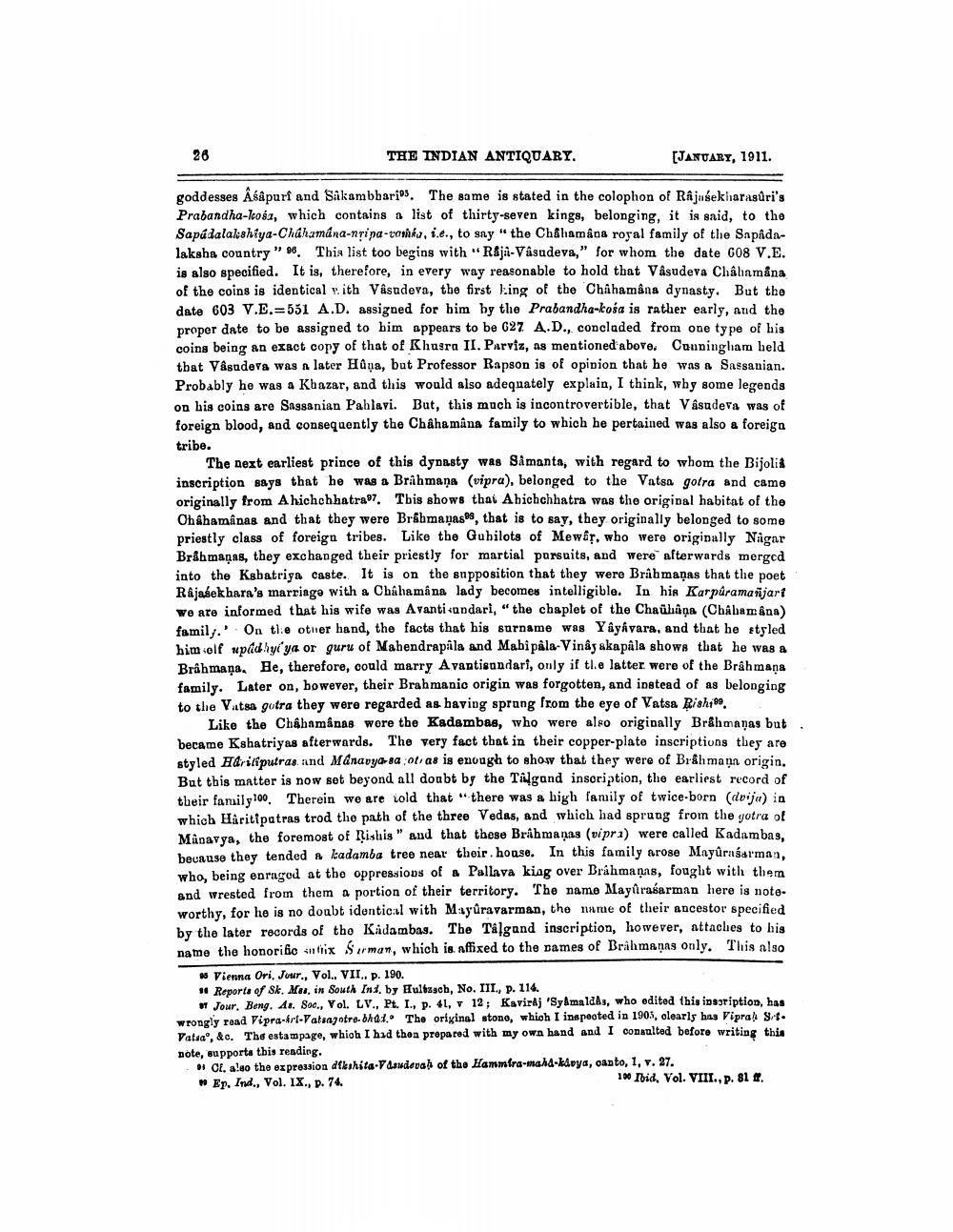________________
26
THE INDIAN ANTIQUARY.
[JANUARY, 1911.
goddesses Âśâpurf and Sakambbarios. The same is stated in the colophon of Rajasekharasûri's Prabandha-kośa, which contains a list of thirty-seven kings, belonging, it is said, to the Sapádalakshiya-Chahamána-nripa-toma, i.e., to say " the Chhamana royal family of the Snpidalaksha country " 98. This list too begins with "Raja-Vasudeva," for whom the date 608 V.E. is also specified. It is, therefore, in every way reasonable to hold that Vasudeva Châlamina of the coins is identical with Vasudeva, the first ling of the Chahamâna dynasty. But the date 603 V.E.=551 A.D. assigned for him by the Prabandha-kośa is rather early, and the proper date to be assigned to him appears to be 627 A.D., concluded from one type of his coins being an exact copy of that of Khusra II. Parviz, as mentioned above. Cunningham held that Vasudeva was later Hana, but Professor Rapson is of opinion that he was a Sassanian. Probably he was a Kbazar, and this would also adequately explain, I think, why some legends on his coins are Sagganian Pahlavi. But, this much is incontrovertible, that Vasudeva was of foreign blood, and consequently the Chaha mâna family to which he pertained was also a foreign tribe.
The next earliest prince of this dynasty was Samanta, with regard to whom the Bijolis inscription says that he was a Brahmana (vipra), belonged to the Vatsa gotra and came originally from A hichchhatrao7. Tbis shows thai Ahichchhatra was the original habitat of the Oh Ahamadas and that they were Brahmaņas, that is to say, they originally belonged to some priestly class of foreign tribes. Like the Gubilots of Mewar, who were originally Nagar Brahmaņas, they exchanged their priestly for martial porsuits, and were afterwards merged into the Kabatriya Caste. It is on the supposition that they were Brabmaņas that the poet Rajasekhara's marriage with a Chahamâna lady becomes intelligible. In his Karpüramanjari We are informed that his wife was Avanti andari, "the chaplet of the Chaühaqa (Chabamina) family. On the other hand, the facts that his surname was Yayavara, and that he styled him olf wpadhy'ya or guru of Mahendrapala and Mabi pâla-Vinay akapala shows that he was a Brahmaņa. He, therefore, could marry Avantisandari, only if the latter were of the Brahmana family. Later on, however, their Brahmanic origin was forgotten, and instead of as belonging to the Vatsa gotra they were regarded as having sprang from the eye of Vatsa Rishi.
Like the Chábamânas were the Kadambas, who were also originally Brahmanas but became Kshatriyas afterwards. The very fact that in their copper-plate inscriptions they are styled Hariliputras and Manavya-8a ot, as is enough to show that they were of Brahmaṇn origin. But this matter is now set beyond all doubt by the Twgand inscription, the earliest record of their family100. Therein we are told that there was a high family of twice-born (dvija) in whicb Haritipatras trod the path of the three Vedas, and which had sprung from the yotra of Månavya, the foremost of Rishis " and that these Brahmaņas (vipra) were called Kadambas, because they tended a leadamba tree near their house. In this family arose Mayůrnsarma, who, being enragod at the oppressions of a Pallava king over Brahmaņas, fought with them and wrested from them a portion of their territory. The name Mayûraśarman here is note. worthy, for he is no doubt identical with Mayůravarman, the name of their ancestor specified by the later records of the Kadambag. The Tálgand inscription, however, attaches to his name the honorifio autix Sirman, which is affixed to the names of Brahmaņas only. This also
* Vienna Ori, Juur., Vol., VII. p. 190. # Reports of Sk. Ma, in South Ind. by Hulbzsch, No. III., p. 114.
Jour, Beng. As. Soc., Vol. LV., Pt. I, p. 41, 12; Kaviraj 'SyAmalds, who odited this insgription, has wrongly road Vipra-Art-Vatsa otrobhal. The original stono, which I inspected in 1905, clearls has Vipra) 8. Vatsa, &o. The estampage, which I had then prepared with my own hand and I consulted before writing this note, supports this reading.
Ol, also the expression dikohita.Vasudoval of the Hamm fra mahd-kavya, oanto, 1, v. 27. * Er. Ind., Vol. IX., p. 74.
190 Ibid. Vol. VIII., p. 81 t.




